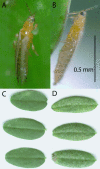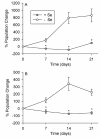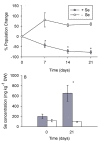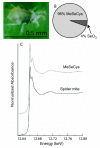Selenium hyperaccumulation offers protection from cell disruptor herbivores
- PMID: 20799959
- PMCID: PMC2940900
- DOI: 10.1186/1472-6785-10-19
Selenium hyperaccumulation offers protection from cell disruptor herbivores
Abstract
Background: Hyperaccumulation, the rare capacity of certain plant species to accumulate toxic trace elements to levels several orders of magnitude higher than other species growing on the same site, is thought to be an elemental defense mechanism against herbivores and pathogens. Previous research has shown that selenium (Se) hyperaccumulation protects plants from a variety of herbivores and pathogens. Selenium hyperaccumulating plants sequester Se in discrete locations in the leaf periphery, making them potentially more susceptible to some herbivore feeding modes than others. In this study we investigate the protective function of Se in the Se hyperaccumulators Stanleya pinnata and Astragalus bisulcatus against two cell disrupting herbivores, the western flower thrips (Frankliniella occidentalis) and the two-spotted spider mite (Tetranychus urticae).
Results: Astragalus bisulcatus and S. pinnata with high Se concentrations (greater than 650 mg Se kg(-1)) were less subject to thrips herbivory than plants with low Se levels (less than 150 mg Se kg(-1)). Furthermore, in plants containing elevated Se levels, leaves with higher concentrations of Se suffered less herbivory than leaves with less Se. Spider mites also preferred to feed on low-Se A. bisulcatus and S. pinnata plants rather than high-Se plants. Spider mite populations on A. bisulcatus decreased after plants were given a higher concentration of Se. Interestingly, spider mites could colonize A. bisulcatus plants containing up to 200 mg Se kg(-1) dry weight, concentrations which are toxic to many other herbivores. Selenium distribution and speciation studies using micro-focused X-ray fluorescence (μXRF) mapping and Se K-edge X-ray absorption spectroscopy revealed that the spider mites accumulated primarily methylselenocysteine, the relatively non-toxic form of Se that is also the predominant form of Se in hyperaccumulators.
Conclusions: This is the first reported study investigating the protective effect of hyperaccumulated Se against cell-disrupting herbivores. The finding that Se protected the two hyperaccumulator species from both cell disruptors lends further support to the elemental defense hypothesis and increases the number of herbivores and feeding modes against which Se has shown a protective effect. Because western flower thrips and two-spotted spider mites are widespread and economically important herbivores, the results from this study also have potential applications in agriculture or horticulture, and implications for the management of Se-rich crops.
Figures







References
-
- Clark LC, Combs GF Jr, Turnbull BW, Slate EH, Chalker DK, Chow J, Davis LS, Glover RA, Graham GF, Gross EG. et al.Effects of selenium supplementation for cancer prevention in patients with carcinoma of the skin: a randomized controlled trial. J Amer Med Assoc. 1996;276:1957–1963. doi: 10.1001/jama.276.24.1957. - DOI - PubMed
-
- Shin SH, Yoon MJ, Kim M, Kim JI, Lee SJ, Lee YS, Bae S. Enhanced lung cancer cell killing by the combination of selenium and ionizing radiation. Oncol Rep. 2007;17:209–216. - PubMed

